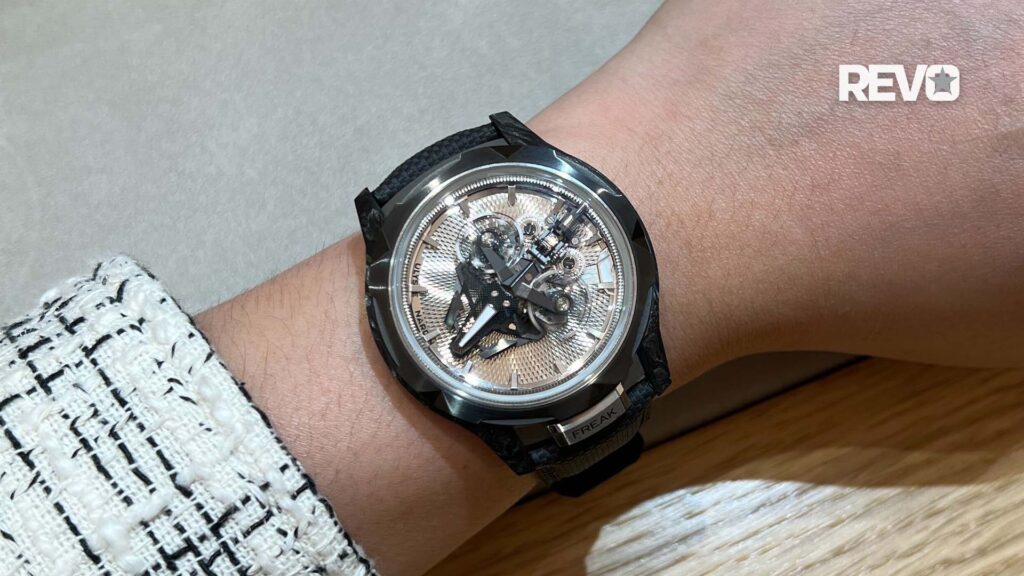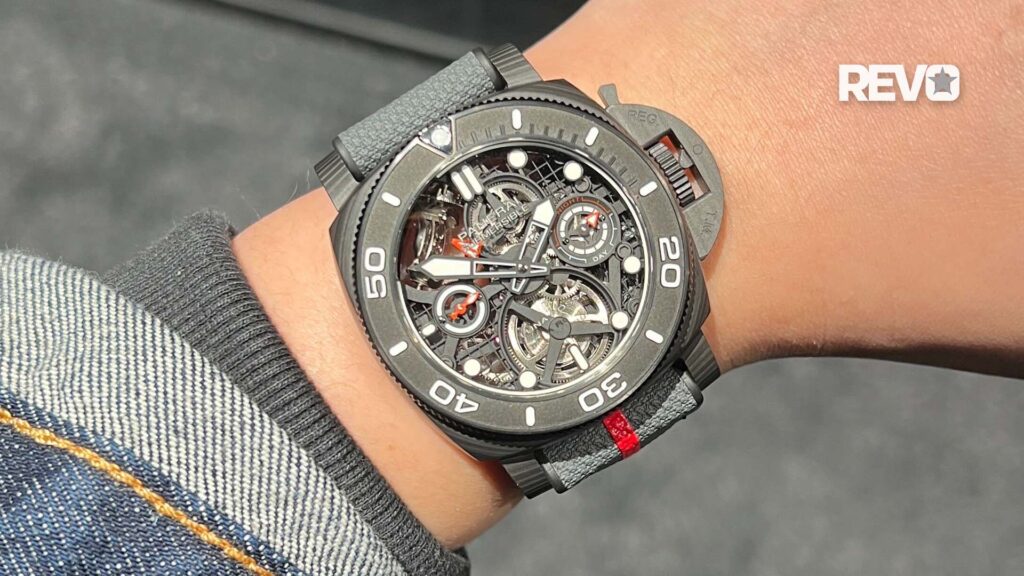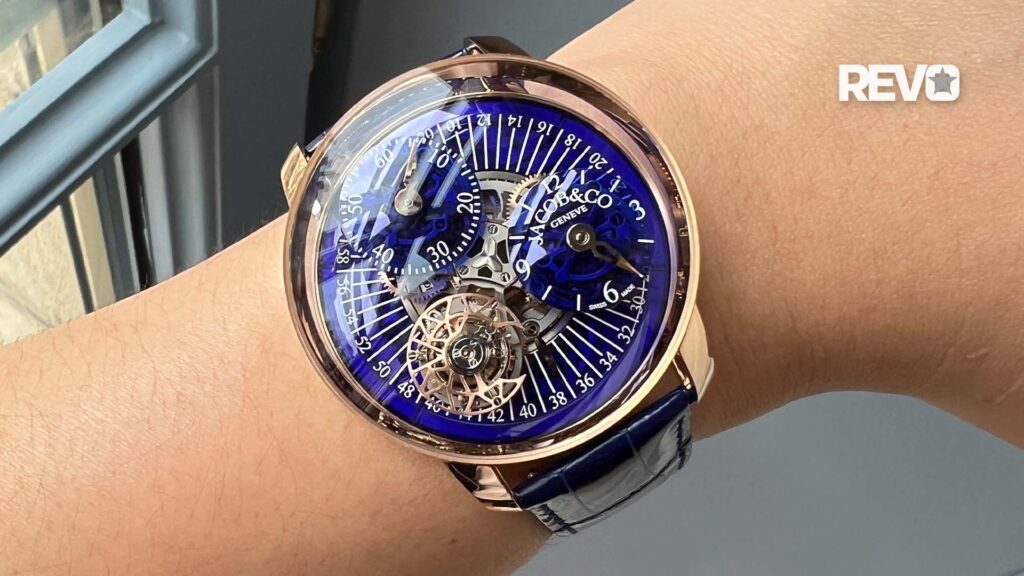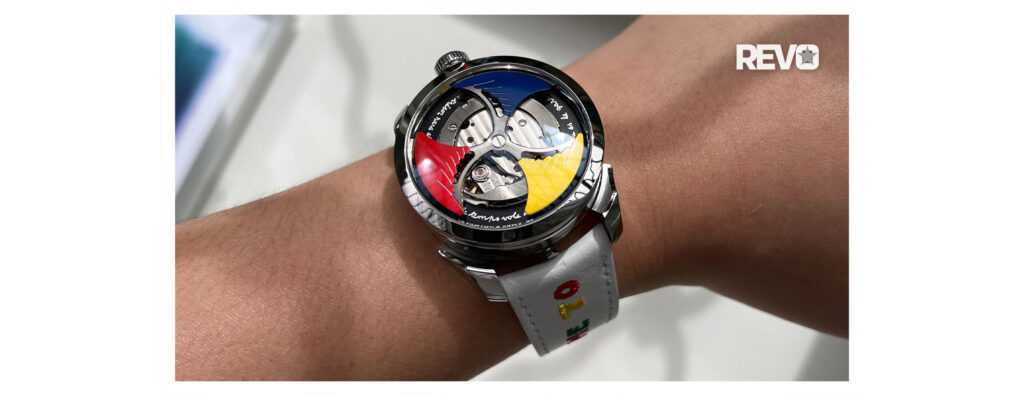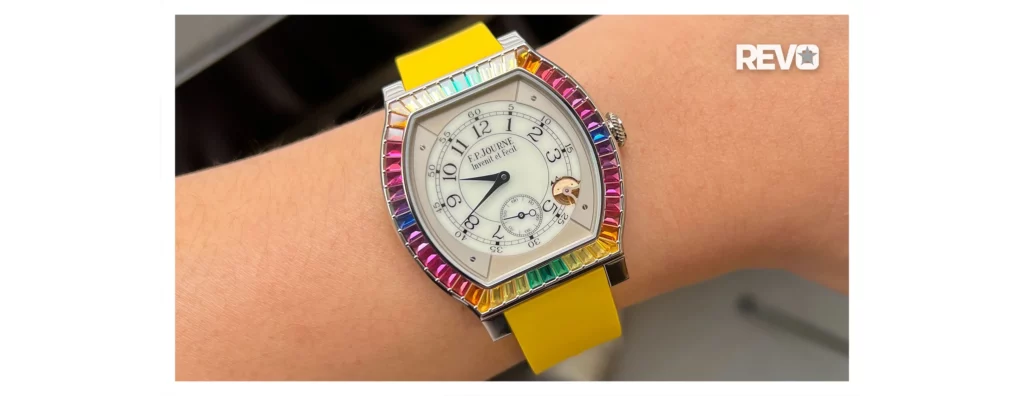Cartier
The pinnacle of evolution: Cartier ID Two
Let’s imagine that Charles Darwin was set loose upon the Huguenot-peopled valleys and mountains of La Chaux-de-Fonds, Le Locle, Le Sentier, Le Brassus, Fleurier and all the parts of Switzerland where silent, stoic men and women sublimate their inner passion into those angelic, refined machines that tell the time.
It’s likely that he would arrive at three categories of watch maisons. The first would be essentially marketing brands that have little or no in-house technical equity and are thus destined to soon perish, no longer contributing to the evolution of the species known as haut-de-gamme horology. The second type would be those conservative manufactures that, while venerable masters of all the traditional complications, shy from new materials and technology — despite their irrefutably tribological, amagnetic, precision-related advantages. Then there would be those maisons that have immersed themselves completely in the study of futuristic materials, amorphous diamond-like carbon (ADLC), silicon and the like, but that may not have the same historical depth as the more conservative firms.
I AM DRAWN BY ITS BREATH AS IF I WERE NO MORE THAN A HELPLESS VAPOR, ALL FALLS ASIDE BUT MYSELF AND IT- WALT WHITMAN, “I SING THE BODY ELECTRIC”
Then as he cast his eyes across the star-strewn, wide-flung horizon and began to eliminate one brand after another for their relative weaknesses, he would come across one that would give him pause. What is extraordinary about this brand, which today possesses immense in-house acumen in classic complications whilst also being one of the most daring high-concept labs dedicated to writing the next chapter in the evolution of the mechanical watch, is that until four years ago, it was largely bereft of in-house technical substance.
That this brand is today one of the most ferociously ambitious and competent manufactures around is testament to the fact that when Cartier decides to do something, it does it with a commitment that is awe-inspiring and definitive. Darwin would have to categorize Cartier as a species unto itself — both a complete manufacture as well as a dream lab dedicated to cutting-edge research on the future of horology.
The man at the helm of this amazingly rich period that encompasses Cartier’s rise to technical predominance is CEO Bernard Fornas. One of his greatest decisions has been to empower ambitious young minds — in particular the Head of Cartier High Watchmaking, Carole Forestier-Kasapi, and the International Watch Marketing Director of Cartier, Thierry Lamouroux.
Together, these two form an evangelical duo, prophesying and then enacting the successive phases of watchmaking progress, while each year introducing an array of outstanding commercial timepieces. The point is that Cartier could have been totally content with the latter without the former. Having rapidly developed in-house movements ranging from basic automatic calibers to a vertical-clutch chronograph; a witty and functional GMT watch to a Geneva Seal Tourbillon; spectacularly original riffs on the classic tourbillon such as the Astrotourbillon to one of the industry’s best minute repeaters — it was wholly unnecessary for them to create a watch like the ID One concept watch in November 2009. So why do it?
The answer was revealed in a recent exhibition of Cartier’s timepieces in Singapore where the most visually arresting installation was focused on the ID One. This single watch was placed front and center in an immense white chamber, while a gigantic magnifying glass created the optical effect of enlarging the ID One to mythological proportions. A fitting effect, since the launch of the ID One was a totemic statement of intent from Cartier.
Says Lamouroux, “The mechanical watch is a fantastic organism. But for several hundred years, there have been few solutions aimed at solving several well-established weaknesses inherent to its design. For the most part, these solutions — everything from the chain and fusée to the pare-chute — have attempted to fix the symptoms, but not address the problems at their source. The idea behind the ID One was to go to the very source of weaknesses in the mechanical watch and resolve this once and for all.”
Carole Forestier-Kasapi adds, “All mechanical watches need some amount of regulation. Often, balance wheels have material removed from them simply to poise them. Then, once they are combined with the hairspring and engaged by the gear train, you still have to regulate them, adjusting them to beat either faster or slower. Even after a watch has been regulated, it can still come out of regulation as a result of shock. In fact, our study demonstrated that two-thirds of all watches brought in for servicing had either become deregulated or magnetized.”
The ID One was meant to be a watch that, from the onset, did not need to be regulated, and as such, could never go out of regulation. In addition, the watch had to be highly resistant to shock, shrug off temperature variations, need no lubrication, and be unaffected by magnetism.
Says Forestier-Kasapi, “To achieve this, we created the escape wheel, the anchor, the balance wheel and escapement bridge out of carbon crystal, using a deep reactive-ion etching (DRIE) process to render parts with incredible precision. Furthermore, the properties of carbon crystal (synthetic diamond) are perfect for this application. Carbon crystal has a low friction coefficifent, so the escapement does not need lubrication. It is also amagnetic, and it is extremely light, which helps optimize power transmission.”
In addition, Cartier created the watch’s hairspring from an amagnetic glass-ceramic composite called Zerodur®, which is etched in a very precise way so as to yield perfect concentric breathing. The escapement bridge itself was isolated from shocks using silent blocks.
Says Cartier CEO Bernard Fornas, “We said when we introduced the ID One that we wanted to demonstrate the future of horology in a concept watch, but that we were also committed to taking elements of this concept watch for use in our commercial timepieces. The first of these is our new Astrotourbillon with carbon-crystal escapement, escapement bridge and tourbillon bridges. At the same time, we continued our research for the ID Two. We are looking at industries from all around the world — from aerospace to sports — to give us ideas on how to improve the mechanical watch’s performance. This kind of creativity lives in the blood of Cartier.”

The synthetic-diamond regulator first seen in the Cartier ID One (pictured) is utilized in the escapement of the recently unveiled Astrotourbillon Carbon Crystal.
The Next Stage of Horological Evolution: ID Two
So it was that upon the announcement of the next chapter in Cartier’s innovative ID project, the speculation was heated and expectations grew nosebleed-high. If you had a satellite image of the sky above Switzerland on the day before the launch of Cartier’s ID Two, it would resemble those diagrams you see depicting the human circulatory system, with blood-bearing tributaries merging into veins and accelerating toward the heart. Such was the convergence of the worldwide press for the unveiling of what could genuinely be described as the most anticipated watch of the year.
The thing is, when you set the bar high, when you smash through previously impassable heights, then the onus is upon you to repeat the act each time you come to the fore. And so it was when the veil was pulled off the ID Two at the Cartier manufacture.
What is the ID Two? It is Cartier’s gloriously ambitious riff on the world’s highest-efficiency watch. It has 32 days of power reserve, thanks to the use of Parylène-coated fiberglass mainsprings inside low-friction ADLC-coated titanium barrels. These barrels work in conjunction with the gear train, which has the addition of a planetary system between the third and fourth wheels to reduce friction and deliver power more symmetrically to the escapement. This entire system is ADLC-coated to eliminate the need for lubrication and minimize frictional energy loss. And most importantly, the entire movement exists inside a near-absolute vacuum of 99.8 percent, virtually eliminating the negative impact of air resistance on the movement — in particular the balance.
How it is that Cartier has managed to achieve something that the best technical minds in the industry have only speculated about? Sit back and let us guide you through the global solution to improving efficiency within the mechanical watch that is embodied by Cartier’s extraordinary ID Two.
Driving Factor: The Barrel
The barrel containing the mainspring is the alpha, the wellspring, and the source of life that animates a watch and transforms it from inanimate metal into a living organism. The barrel is the power source that sends energy through the gear train to the heart of the watch, which consists of the escapement and the oscillator. The spring inside the barrel is fixed on one end to the barrel arbor so that as the barrel is wound, the spring coils compactly into itself — in this state, energy is stored as potential energy. It releases energy by slowly uncoiling, and in this state the stored energy is converted to released energy, mostly in kinetic form.
The cumulative potential energy in any barrel is measured in days, and is considered to be that watch’s power reserve. So how do you go about creating a watch with a far greater power reserve than most? One famous example is the 31-day power reserve watch known as the Lange 31. However the Lange 31 uses an enormous barrel to contain a huge mainspring. There are two undesirable results with this. The first is that its wearer must have a wrist of suitably herculean proportions to don such a behemoth; secondly, the quality of power from the mainspring over the 31 days varies erratically over its lifespan.
The problem is that, as a barrel unwinds, its torque begins to drop until it reaches a state where the energy supplied to the balance is insufficient to maintain its amplitude within the optimum range. This is undesirable, and can compromise the watch’s performance. A solution to this would be to stop the watch before the barrel is fully unwound. But this truncates the power reserve. Or, as in the case of the Lange, the watch can be fitted with a constant-force mechanism that isolates the impulse to the balance from the direct influence of the gear train.
Says Lamouroux, “Look, these solutions have been with us for several hundred years, but in many ways they simply address the symptoms related to the weakness of the barrel’s inherent material and design, rather than solving the problem at its source.”
To create a watch with an amazing 32-day power reserve, Forestier-Kasapi, Lamouroux and the Cartier watchmaking team knew that they had to improve the efficiency of the mechanical watch in each area of weakness: the barrel, the gear train and the oscillator. In each instance, their solution would be related to both new materials and new designs, allowing for far greater levels of efficiency and performance.
Watchmakers have been using metal mainsprings since time immemorial, and today, the majority of brands still purchase their Nivaflex (a compound created in the 1970s) mainsprings from the mighty Nivarox, the Swatch-owned king of micro-regulation components. As the objective was to be able to store more energy with a barrel of the same dimensions, this led the Cartier team to test many materials for suitability as barrel springs. In the end, they selected fiberglass. They discovered that fiberglass demonstrated the absolute best potential to store energy. It is able to store 18-percent more energy than a comparable metal spring.
What is fiberglass? Also known as glass-reinforced plastic, it is lightweight, extremely strong and robust, and far more elastic than carbon fiber. It is used for pole-vaulter poles, thanks to its ability to store then release energy, and in both boats and cars (remember the incredible Corvette Stingray?) to create complex, lightweight and strong bodies. It is highly plastic, can be molded, and thus can be made in a great variety of shapes.
Says Lamouroux, “Fiberglass mainsprings can be molded in such a way that they are thinner on the outside and thicker toward the center of the coil, so that barrel torque remains consistent throughout the power reserve. It is our ambition to implement this kind of self-compensating barrel-spring technology across a wide range of watches in the future, because this does away with the need for a constant-force device. It fixes the problem of varying torque at its source.”
However, creating a fiberglass mainspring is not simply a matter of replicating the configuration of a metal mainspring. To begin with, in precisely the same dimensions as a conventional metal barrel, the ID2’s barrel features two sets of stacked barrels, each turning in opposite directions. The thickness of the fiberglass springs is increased relative to a metal one, and there are fewer coils.
In a normal barrel, the amount of released kinetic energy differs from the amount of stored energy, because a certain percentage of it is lost to friction. This arises from mainspring coils getting stuck to each other and also from friction against the inner surfaces of the barrel. To eliminate these types of friction, the fiberglass spring gets a Parylène polymer coating. At the same time, the barrel is made from titanium coated with ADLC, which imparts a particularly low friction coefficient.
The result is a gain of 30 percent in the conversion of stored energy to released energy — 12 percent of this attributable to the improved design, and 18 percent due to the new materials used in ID Two’s mainspring barrel.
The wheels of progress: High-Efficiency Transmission
The basic gear train of the mechanical watch has also been with us since the dawn of horology. Its function is to transform a high-torque, low-speed energy source (the barrel spring) to a low-torque, high-speed impulse for the escapement. Think about it this way — the barrel makes about one-third of a turn per hour, while the escape wheel makes 720 rotations per hour. During this process, power is reduced from 2.5 to 0.001 Newton millimeters of torque. Between these two endpoints, the center, third and fourth wheels each play a role in reducing torque and increasing speed.
The problem is that enormous amounts of energy are lost through friction in gear engagement. Even small amounts of play between gear teeth can also result in an overall loss of energy in transmission. There is also a problem known as “side-load”, where the pressure exerted on pinions by gear torque causes the pivots to be laterally pressed against the interior surfaces of the jewels and end stones, causing additional friction.

Energy loss due to friction is minimized in this setup, thanks to the ADLC-coated wheels and differential gear system.
What was Cartier’s solution? To implement a differential gear train, though we could just as accurately call this system planetary gears or epicyclical differential gears. This system is based on one of the most ancient mechanical constructs on earth and gets its name from the way it emulates the rotation of the planets around the sun.
Cartier’s differential gear train works in the following way. The third wheel drives the sun gear, which is the toothed wheel located in the center of the system. This wheel drives the elliptical-shaped carrier that carries the pinions for the two planetary wheels. Note that this carrier rotates on ceramic ball bearings. These two planetary wheels are geared to the large annulus gear, which is the wheel on the outside with inward-facing teeth.
Finally these two planetary wheels are geared to the exit gear, which is obscured in the image, but sends energy to the escapement. Because the exit gear is driven on both sides, providing a constant centering effect, the power delivered to it is extremely symmetrical and no side-load occurs in this case.
To further improve the efficiency of power delivery, tooth profiles have been optimized. Cartier is able to execute these incredibly precise tooth profiles thanks to the deep reactive-ion etching (DRIE) process used to make all the carbon-crystal-coated silicon wheels found in the differential gear train. The pinions are made of ADLC-coated steel, and the pivots of the escapement are in ADLC-coated titanium. These silicon wheels are harder and 70-percent lighter than they would be if made in metal.
Looking at this design, the only thing that was not ideal was that it does not inherently allow for a direct seconds wheel. To be clear, there is a seconds wheel in the design, driven by the exit gear of the planetary system, and that in turn drives the escape wheel. The design of the gear train, however, makes it impossible to extend a pinion from the center of this wheel to either the dial or back of the watch to fix a seconds hand.
With all the tremendous savings of power, the implications of the self-compensating torque of the fiberglass mainsprings and the complete removal of air resistance at the oscillator, clearly the foremost question is — how accurate is the ID Two? The idea of creating a parasitical indirect seconds display to provide any meaningful indication of timekeeping precision would both compromise the aesthetic purity of the movement as well as the results of any chronometric test.
When asked about this, Carole Forestier-Kasapi replied, “The goal with the ID Two was to create an extremely high-efficiency watch, but yes, I recognize that many of the advantages of this watch — in particular the fact that the oscillator vibrates in a vacuum — has enormous chronometric implications at higher vibrational speeds, but that was not the goal of this watch.”
Lamouroux continues, “Yes, with no air friction of course we could elevate the vibrational speed and pursue increased chronometry, but this was not the goal. There are many brands on the market pursuing high frequency, and we did not want to go down this path. At least not yet! But maybe for ID Three.”
The end result of the differential gear train is to simultaneously reduce friction coefficient to one-fifth of that generated by a traditional steel and brass gear train, as well as increasing by 10 percent the energy successfully transmitted from the barrel to the escapement. As with the fiberglass barrels found in the ID Two, these advantages are the result of innovation both in material as well as design. Using these two focal points, the ID Two is able to reduce gear speed, reduce friction, reduce pivot load, increase precision, decrease side-load and offer a totally lubrication-free train.

The spectacularly transparent Ceramyst- a polycrystalline ceramic- case is the first to utilize a monobloc case-and-dial-crystal construction.
An airtight proposal: The Vacuum case
In a study conducted by Cartier, it was determined that the loss of energy at the balance wheel can be attributed 20 percent to the friction between the pivots and the end stones and an amazing 80 percent to air friction. Air resistance therefore plays a huge role in reducing the efficiency of the oscillator, a fact that Lamouroux explains has multiple precedents in the real world. Our indomitable in-house Cartier expert and online forum moderator George Cramer points out: “An A380 Airbus consumes roughly 2,800L[740gal] of kerosene per 100km [62miles] when it flies at an altitude of 1,000m [3,280ft]. Air pressure declines by 75 percent at a cruising altitude of 12,000m [39,370ft], where the aircraft burns only 800L [211gal] per 100km [62miles].”
Cartier began addressing the friction of the balance wheel at its shaft. In the ID Two, the balance pivot shaft is made from titanium and coated in ADLC, and mounted directly into the carbon-crystal balance bridge. A lubricated steel pivot in jewel end stones would have a friction coefficient of 0.15, while in Cartier’s solution, this is reduced to 0.04. Part of this is also because the pivot walls are convex in shape so as to decrease the area contacting the bridge by 16 percent. But clearly, based on the brand’s analysis, friction resulting from this contact is a minor issue. The major issue is related to air resistance!
So, how do you get rid of air friction? Well, you remove all the air from inside the watch. Says Lamouroux, “There have been previous attempts to create a vacuum in a watch.” He refers to Century Time Gems, a brand initially known as the Vacuum Chronometer Corp., in which an air void of 80 percent could be created and maintained. Lamouroux continues, “But you must understand that the objective with Century was to remove the moisture and impurities inside the watch. However, at 80-percent void, there would be no positive effect on the efficiency and performance of the watch. In our own studies, we’ve seen that the efficiency of the watch, represented by the significant increase in amplitude of the balance wheel, only occurs around 99-percent air void.”
The ID Two is the world’s first watch with 99.8 percent of absolute vacuum, which means it contains 500 times fewer air molecules than in a normal timepiece. One of the major hurdles facing creating a vacuum watch was that the oils inside vaporize in this condition. This is a process called degassing, where liquid in a vacuum actually boils and converts to gaseous form, due to the absence of air pressure. Says Carole Forestier-Kasapi, “It is only because of the ID One, which gave us a totally lubricant-free watch, that the ID Two is possible. Because there is no oil, there is no issue of degassing.”
Lamouroux adds to this, “You can see that there is a logical progression in Cartier’s ID projects.” When asked again if the elimination of aerodynamic turbulence inside the watch has big implications related to elevation of the vibrational speed of the oscillator, he smiles and replies, “Yes of course, but this was not the objective with the ID Two. There are many projects now that are related to high frequency, but our goal was high efficiency. Of course our next watch could utilize the advantages of the vacuum for other purposes.”
Says Carole Forestier-Kasapi, “One major advantage of a more efficient watch relates to the addition of complications. Every complication that is added to a mechanical watch begins to compromise its underlying function because it draws power away.” Pay close attention the next time your perpetual calendar stops. Odds are that it stopped precisely during the date-change function because of the additional load
this represents to the underlying movement. Forestier-Kasapi continues, “With a more efficient watch, you start with a superior platform upon which to build your complications.”
But how exactly does a vacuum help the efficiency of watch? In order to understand that, you need to understand what “quality factor” means. Quality factor is when you charge the hairspring on a balance and then let it oscillate freely until it stops. The balance wheel in the Cartier caliber 1904 has a quality factor of 300, meaning that it will make 300 small swings until it stops dead. The time it takes for this to happen is two minutes, but take exactly the same balance wheel, extract 99.8 percent of the air from around it, and the quality factor increases to 450 — or by 50 percent — and it takes a full three minutes before the hairspring stops oscillating.
But there is more. Each clockwise and counter-clockwise rotation of the balance wheel is considered one beat. The degree of rotation of the balance wheel with each beat is the amplitude. Ideally, balance amplitude should fall somewhere between 275° and 315°. In order to achieve this, a significant amount of power needs to be transmitted from the barrel through the gear train and finally to the escape wheel. Each time the wheel is unlocked by the anchor, it simultaneously sends a pulse of energy to the anchor, which strikes the impulse pin on the roller table of the balance wheel. This pulse essentially has to be strong enough to consistently lift the balance wheel to the right amplitude.
But Cartier discovered something very interesting when they placed their watch in a vacuum. As they had essentially eliminated air friction, the balance wheels would suddenly have 40° to 50° more amplitude, because there was no aerodynamic resistance to overcome.
Says Thierry Lamouroux, “When the ID Two was created, the amplitude of its balance wheel was calculated to be a significant number of degrees below the optimum when not in a vacuum. When we extracted 99.8 percent of the air, the balance wheel reached ideal amplitude while needing much less power to do so.” Indeed, Cartier reports that the vacuum allows the balance to be powered with 37-percent energy savings.
But how do you create — and more importantly maintain — a vacuum inside a mechanical watch? Lamouroux explains, “Clearly the weak point for air penetration in any watch is at the joints, and more specifically the gasket-sealed parts. So to begin with, our objective was to build a monobloc case with fewer gaskets.”
Most watches feature a sapphire crystal or mineral glass that is mounted onto the watchcase and retained by a bezel. But Cartier wanted to eliminate these different parts of the watchcase completely and integrate as many parts as possible. It was obvious that if the case and crystal were to be made from the same material, it would have to be clear, strong and highly scratch-resistant.
For the ID Two, Cartier’s team created the world’s first transparent polycrystalline ceramic watchcases with integrated crystal made from a material called Ceramyst™. The advantages of ceramic are that parts can be molded into a wide variety of shapes, and that the material is extremely hard and scratch-resistant. It is important to note that as opposed to other transparent watches such as the sapphire-crystal-cased timepiece introduced by Richard Mille this year, here the objective was to create the case and crystal as one element. Furthermore, the fact that Ceramyst™ can be molded into a wide variety of elaborate shapes holds enormous implications when considering Cartier’s vast pantheon of creatively shaped cases.
Even though Cartier managed to reduce the overall gasket length of their watch by 48 percent, there were still two sets of gaskets found in the ID Two. The first is the gasket for the caseback and the second is the gasket surrounding the winding stem. Normal gaskets are built to keep water out, but water molecules are far larger than air molecules; which means that the conventional gaskets found in other watches simply can’t do the job. To further fortify these gaskets against air incursions, Cartier “doped” them with nanoparticles, which seals the gas-permeable gaps found in normal gaskets. In addition, the “high roughness” or hardness of the Ceramyst™ case allows for a better seal with the gasket. The only other gaskets found in the watch are two small ones used to seal the crown. It is also through this crown that air is extracted.
In a standard watch, even one that is water resistant to 30m (98ft), a vacuum formed inside the case will return to normal atmospheric pressure within one day. Using the monobloc Ceramyst™ case and its nanoparticle-doped gaskets, the ID Two can maintain its vacuum for 10 years. The vacuum effect is so strong that the watch’s caseback is retained solely by air pressure. Look closely: you will not see a single screw.
It should be mentioned that the escapement bridge with silent blocks, balance wheel and plasma-polished monobloc anchor and escape wheel are all made from carbon crystal and the hairspring is crafted from Zerodur® just as they were in the ID One. Taken in totality, they represent a 15-percent gain in energy efficiency compared to a conventional balance and escapement. A nice design flourish is the placement of the transparent escape wheel dead center on the dial side, creating a lively yet ethereal event that is as aesthetically hypnotic as it is functionally brilliant. But then again, that’s something you could say about the entire watch.














